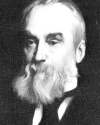 | TODAY IN SCIENCE HISTORY NEWSLETTER - 4 MARCH |
| Feature for Today |
 On 4 Mar 1890, the Forth Railway Bridge was opened, spanning the Forth river between Edinburgh and Dundee, Scotland. Its total length of 8300-ft is spanned with three double cantilevers. On 4 Mar 1890, the Forth Railway Bridge was opened, spanning the Forth river between Edinburgh and Dundee, Scotland. Its total length of 8300-ft is spanned with three double cantilevers.Benjamin Baker, one of its designers, at a Royal Institution Lecture in 1887 gave an interesting demonstration of the engineering principles involved, using two men with arms outstretched representing the cantilevers, supporting the weight of a third man between their arms. To see this attention-grabbing demonstration read a short article on the Human Cantilever. You'll have time left to read another short article with some remarks by Benjamin Baker explaining how engineering disasters resulted from failure of metal structures—Metal Fatigue. |
| Book of the Day | |
| |
| Quotations for Today | |
 | "It took less than an hour to make the atoms, a few hundred million years to make the stars and planets, but five billion years to make man!" |
 | "The doctrine of evolution implies the passage from the most organised to the least organised, or, in other terms, from the most general to the most special. Roughly, we say that there is a gradual 'adding on' of the more and more special, a continual adding on of new organisations. But this 'adding on' is at the same time a 'keeping down'. The higher nervous arrangements evolved out of the lower keep down those lower, just as a government evolved out of a nation controls as well as directs that nation." |
 | "I attained a triumph so complete that it is now rare to meet an American with marks of small pox on his face... Benefits are valuable according to their duration and extent, like the showers from heaven, but the benign remedy Vaccination saves millions of lives every century, like the blessing of the sun, universal and everlasting." (Remark made near the end of his life.) |
| QUIZ | |
| Before you look at today's web page, see if you can answer some of these questions about the events that happened on this day. Some of the names are very familiar. Others will likely stump you. Tickle your curiosity with these questions, then check your answers on today's web page. | |
| Births | |
 |  An African-American inventor, born 4 Mar 1864, established the Cleveland Call (1920), invented a hair straightening solution, woman's hat fastener, an automobile clutch, a "breathing device" which became a gas mask used in WW I, and a traffic signal. An African-American inventor, born 4 Mar 1864, established the Cleveland Call (1920), invented a hair straightening solution, woman's hat fastener, an automobile clutch, a "breathing device" which became a gas mask used in WW I, and a traffic signal.  Can you name this inventor? Can you name this inventor? |
| Deaths | |
 |  Ira Remsen (1846-1927) was an American chemist. During the synthesis of orthobenzoyl sulfimide (1879), he had a student working under his direction who accidentally discovered it had an intensely sweet taste by touching his fingers to his lips while unknowingly having a few grains on them. The compound was patented. Ira Remsen (1846-1927) was an American chemist. During the synthesis of orthobenzoyl sulfimide (1879), he had a student working under his direction who accidentally discovered it had an intensely sweet taste by touching his fingers to his lips while unknowingly having a few grains on them. The compound was patented. |
 |  Jean-Fran�ois Champollion (1790-1832) was a French historian and linguist. Jean-Fran�ois Champollion (1790-1832) was a French historian and linguist.  What were his scientific accomplishments? What were his scientific accomplishments? |
| Events | |
 |  On 4 Mar 1930, the Coolidge Dam in Arizona was dedicated by President Calvin Coolidge. Built on the San Carlos Indian Reservation, it irrigates 100,000 acres. Coolidge Dam was designed and constructed, and is owned and operated, by the Bureau of Indian Affairs (BIA), and was contructed between 1924 and 1928. On 4 Mar 1930, the Coolidge Dam in Arizona was dedicated by President Calvin Coolidge. Built on the San Carlos Indian Reservation, it irrigates 100,000 acres. Coolidge Dam was designed and constructed, and is owned and operated, by the Bureau of Indian Affairs (BIA), and was contructed between 1924 and 1928.  On which river was the Coolidge Dam constructed? On which river was the Coolidge Dam constructed? |
 |  On 4 Mar of a certain year, the world's first commercial photography studio was opened in New York City by John Johnson and Alexander S. Wolcott. They had spent several months experimenting in various aspects of the construction of the camera, lighting, and using persons as subjects, exposing and processing Daguerreotypes. On 4 Mar of a certain year, the world's first commercial photography studio was opened in New York City by John Johnson and Alexander S. Wolcott. They had spent several months experimenting in various aspects of the construction of the camera, lighting, and using persons as subjects, exposing and processing Daguerreotypes.  In which decade was their studio opened? In which decade was their studio opened? |
| Answers |
When you have your answers ready to all the questions above, you'll find all the information to check them, and more, on the March 4 web page of Today in Science History. Or, try this link first for just the brief answers. Fast answers for the previous newsletter for March 3: Scotland; oral polio vaccine; Robert Hooke; the decade including the year 1885. |
| Feedback |
 If you enjoy this newsletter, the website, or wish to offer encouragement or ideas, please send feedback by using your mail reader Reply button. If you enjoy this newsletter, the website, or wish to offer encouragement or ideas, please send feedback by using your mail reader Reply button. |
--
If you do not want to receive any more newsletters, Unsubscribe
To update your preferences and to unsubscribe visit this link


Δεν υπάρχουν σχόλια:
Δημοσίευση σχολίου